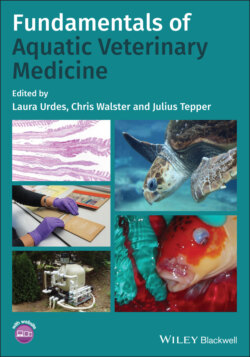Читать книгу Fundamentals of Aquatic Veterinary Medicine - Группа авторов - Страница 41
1.3.2.14 Ammonia, Nitrite and Nitrate
ОглавлениеAmmonia is a colorless, odorless substance which can accumulate in aquasystems and cause direct mortality, a decrease in production and increased incidence of many diseases. In water, ammonia occurs in two forms, which together are called the total ammonia nitrogen. Ammonia gas is usually released from the gills or from decomposing organics dissolved in the water. Some reacts with the water to produce ammonia ions. The remainder is present as un‐ionized, which is acutely toxic to aquatic life. Chemically, these two forms are represented as NH4+ and NH3. NH4+ is called ionized ammonia because it has a positive electrical charge, and NH3 is called un‐ionized ammonia (UIA), since it has no charge. This is important to know, since NH3, UIA is the form that is toxic to fish. The percentage of UIA in solution depends on the pH and temperature of the water; as both go higher, so does the toxicity.
A typical aquasystem has bacteria, which in the presence of dissolved oxygen converts (oxidizes) ammonia to the intermediate form of nitrite and then to nitrate. Ammonia is converted into nitrite (NO2–) due to the influence of Nitrosomonas bacteria. Nitrite (NO2–) is converted into nitrate (NO3–) due to the influence of Nitrobacter bacteria. Most test kits measure total ammonia nitrogen, so the aquarist must determine what percentage of the total is toxic.
Nitrite is an intermediate in the oxidation of ammonium to nitrate. Nitrite is less toxic to fish than ammonia. An elevated ambient nitrite concentration is a potential problem for freshwater fish since nitrite is actively taken up across the gills in competition with chloride. Nitrite is a well‐known toxicant for fish, as well as a disrupter of multiple physiological functions including ion regulatory, respiratory, cardiovascular, endocrine and excretory processes. One critical consequence of nitrite accumulation is the oxidation of hemoglobin to methemoglobin, compromising blood oxygen transport (Kroupova et al., 2005). Nitrite toxicity to fish varies considerably and depends on many external and internal factors. Among the most important ones are water quality (e.g. pH, temperature, cation, anion and oxygen concentration), length of exposure, fish species, fish size and age, and individual fish susceptibility.
Nitrate is relatively non‐toxic; however, high concentrations reduce animal growth and can decrease survival. For example, concentrations over about 400 mg NO3–N/l have been shown to depress the growth rate and survival of marine shrimp (Litopenaeus vannamei). In intensive biofloc aquaculture systems used for shrimp culture, concentrations of 400 mg NO3–N/l have been observed after using water for roughly three culture cycles. Salinity influences the toxicity of nitrate, as it does with ammonia and nitrite. At higher salinities, these compounds are less toxic to aquatic animals. Several options exist for dealing with nitrate, including water exchange, phytoremediation, denitrification, and heterotrophic assimilation (Svobodova and Kolarova, 2004; Svobodova et al., 2005; Tepper, 2000).
It is recommended that un‐ionized ammonia should be less than 0.02 ppm to prevent stress and reduced growth. Ammonia has been reported to be lethal to catfish at about 0.4 ppm (Jensen, 2003). Ammonia, nitrite and nitrate are labile ions and must be analyzed rapidly or samples frozen as soon as possible after filtration. Samples that cannot be submitted within a few hours should be filtered (0.45 mm) then frozen to reduce the loss of ammonia and changes in nitrite/nitrate concentrations. Plain blood collection tubes are suitable containers for freezing. Two 10‐ml tubes will provide enough samples for all three tests. Do not fill completely; leave space for expansion during freezing.
